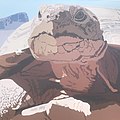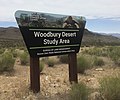Beaver Dam Wash National Conservation Area
| Beaver Dam Wash National Conservation Area | |
|---|---|
IUCN category V (protected landscape/seascape) | |
 Beaver Dam Wash National Conservation Area | |
| Location | Washington County, Utah, United States |
| Nearest city | St. George, Utah |
| Coordinates | 37°03′14″N 113°58′55″W / 37.054°N 113.982°W |
| Area | 63,500 acres (257 km2) |
| Established | 2009 |
| Governing body | Bureau of Land Management |
| Official website | |
The Beaver Dam Wash National Conservation Area is a 63,500-acre (257 km2) United States National Conservation Area located in southwest Utah west of St. George along the borders with Arizona and Nevada.[1] It is managed by the U.S. Bureau of Land Management as part of the National Landscape Conservation System, and was authorized in the Omnibus Public Land Management Act of 2009.[2]
The Beaver Dam Wash National Conservation Area (NCA) is drained by Beaver Dam Wash in the watershed of the Virgin River, a tributary of the Colorado River.[3] The NCA provides habitat for the desert tortoise, bighorn sheep, Joshua trees, and other threatened and sensitive species.
Gallery
[edit]-
Beaver Dam Wash National Conservation Area Signboard
-
Driving in The Beaver Dam Wash National Conservation Area
-
BLM Sign Detail
-
Representative landscape of the Beaver Dam Wash NCA
-
Eastern Joshua Tree (Yucca jaegeriana) at Beaver Dam Wash National Conservation Area
-
Representative landscape of the Joshua Tree National Natural Monument
-
Typical Landscape at the Joshua National Natural Monument
-
Beaver Dam Wash National Conservation Area
-
Woodbury desert study area sign
-
Mojave Desert Joshua Tree Road Sign
References
[edit]- ^ Staff. "Beaver Dam National Conservation Area, Utah". Public Lands Information Center. Archived from the original on January 2, 2014. Retrieved May 26, 2012.
- ^ Holt, Rush D. (March 30, 2009), Omnibus Public Land Management Act of 2009, Washington, DC: Library of Congress, archived from the original on December 12, 2012, retrieved May 26, 2012
- ^ Staff. "Beaver Dam Wash National Conservation Area". St. George Field Office, Bureau of Land Management. Archived from the original on March 29, 2013. Retrieved May 26, 2012.
![]() This article incorporates public domain material from websites or documents of the Bureau of Land Management.
This article incorporates public domain material from websites or documents of the Bureau of Land Management.









